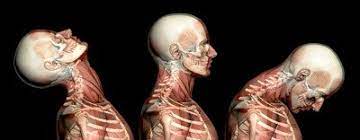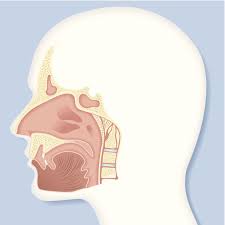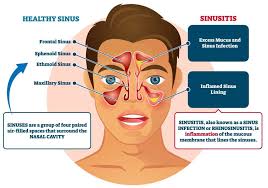

Posture plays a critical role in maintaining overall health, and one of its lesser-known effects involves the connection between neck alignment and nasal passage function.
Poor neck posture, particularly forward head posture (FHP), can compress the nasal passages, leading to difficulties in breathing, sinus issues, and disrupted airflow.
In this article, we will explore the intricate anatomical and physiological relationships between neck posture and nasal passage health, supported by scientific research and real-life examples.
Table of Contents
- Introduction to Neck Posture and Respiratory Function
- Anatomy of the Neck and Nasal Passages
- 2.1. Structural Connections Between the Neck and Nasal Passages
- 2.2. Role of Muscles and Fascia in Nasal Function
- How Poor Neck Posture Compresses Nasal Passages
- 3.1. Forward Head Posture (FHP) and Its Impact on Airway Space
- 3.2. Impaired Muscular Balance and Nasal Passage Compression
- 3.3. The Role of Cervical Spine Misalignment in Breathing Difficulties
- Real-Life Examples of Poor Neck Posture Affecting Nasal Function
- 4.1. Case Study: Office Worker Experiencing Chronic Nasal Congestion
- 4.2. Case Study: Student Struggling with Sleep Apnea Symptoms
- Conclusion
A Quick Look at Neck Posture and Respiratory Function
Neck posture is not just about looking poised on video calls—it is about how well you breathe, too.
When your head sits gracefully above your spine, everything from your airways to your diaphragm works in harmony.
But shift that head forward like you’re trying to kiss your screen, and your lungs pay the price.
What Research Shows?
Scientific studies have repeatedly confirmed that forward head posture (FHP) reduces vital lung metrics such as forced expiratory volume and overall vital capacity. Simply put, your ability to take in and expel air gets compromised when your neck alignment is off.
Postural changes in the neck also alter rib cage mechanics. The upper chest becomes overactive while the lower ribs compress, impairing the diaphragm’s ability to contract effectively. Several studies note that individuals with FHP exhibit weaker inspiratory and expiratory muscle strength, meaning they struggle more with deep breathing tasks.
What is Happening Physically?
The shift in head position puts added strain on muscles like the sternocleidomastoid and scalene group. These accessory breathing muscles are not designed to do the diaphragm’s job full-time. Overuse can lead to shallow and inefficient breathing that leaves you tired and gasping—especially during physical activity.
The Takeaway:
Imagine your lungs as opera singers—they need a well-structured stage (your posture) to hit the high notes. Slouch, and you might as well be stuffing them in a coat closet.
The solution is not to stand like a robot. Instead, integrate cervical retractions exercises, thoracic mobility drills, and deep belly breathing into your routine. These small changes support your spine, liberate your lungs, and help you breathe like a relaxed yoga master instead of a stressed-out desk jockey.
Posture is not just for aesthetics—it’s your breath’s best friend.
Anatomy of the Neck and Nasal Passages
Here is how your nasal passage functions:
Structural Connections Between the Neck and Nasal Passages:
The neck and nasal passages are connected through a network of bones, muscles, and soft tissues.
The nasal passages rely on structural support from the skull and upper cervical spine, particularly the C1 (atlas) and C2 (axis) vertebrae. Misalignment in this area can exert pressure on surrounding tissues, indirectly affecting the nasal airways.
The upper cervical spine also influences the alignment of the pharynx and nasal cavity, which are critical for maintaining proper airflow. When the neck is out of alignment, it can compress these structures, causing restricted airflow and nasal congestion.
Role of Muscles and Fascia in Nasal Function:
The muscles and fascia in the neck, particularly the sternocleidomastoid, scalene, and suboccipital muscles, play a significant role in respiratory mechanics.
Poor posture can cause these muscles to become tight and overworked, exerting pressure on the surrounding tissues and indirectly narrowing the nasal passages.
A study published in The Journal of Bodywork and Movement Therapies (Wang et al., 2017) found that fascial tightness in the neck and shoulders could significantly reduce airflow through the nasal cavity, highlighting the interconnectedness of these structures.
How Poor Neck Posture Compresses Nasal Passages?
Here is how it happens in real life:
Forward Head Posture (FHP) and Its Impact on Airway Space
Forward head posture, where the head shifts forward relative to the shoulders, is one of the most common forms of poor neck posture. This misalignment places additional stress on the cervical spine and surrounding tissues, which can impact the airway.
When the head juts forward, it compresses the oropharyngeal and nasopharyngeal space, leading to restricted nasal airflow. Research published in Clinical Biomechanics (Neuman et al., 2015) demonstrated that individuals with FHP experienced significantly reduced airflow through their nasal passages, further supporting the link between posture and respiration.
Impaired Muscular Balance and Nasal Passage Compression
Poor posture causes imbalances in the neck muscles, particularly the suboccipital muscles and levator scapulae, which can tighten and pull on surrounding structures. This creates tension in the soft tissues supporting the nasal passages, narrowing the space available for air to pass through.
For example, tight suboccipital muscles can compress the nasopharyngeal space, making it harder to breathe through the nose. Chronic muscular imbalances from poor posture can also contribute to deviated septa or increased pressure in the sinuses, exacerbating nasal issues.
The Role of Cervical Spine Misalignment in Breathing Difficulties
The cervical spine’s alignment directly affects the airway. When the neck is out of alignment, it disrupts the natural curvature of the spine, increasing pressure on the pharyngeal airway and nasal cavity. A misaligned C2 vertebra can also impinge on nerves that regulate breathing and sinus function.
A study in Spine (Harrison et al., 2004) highlighted how cervical misalignment is linked to increased respiratory effort, further emphasizing the importance of proper neck posture in maintaining nasal and airway health.
Real-Life Examples of Poor Neck Posture Affecting Nasal Function
Here are two case studies that we would like to share with you:
Jane Experiencing Chronic Nasal Congestion:
Jane, a 38-year-old office worker, began noticing persistent nasal congestion shortly after transitioning to a desk job that required her to sit for extended periods.
The congestion wasn’t associated with allergies or sinus infections, leaving her puzzled about the root cause. Over time, she also experienced tightness in her neck and shoulders, along with mild tension headaches.
A consultation with a physical therapist revealed that Jane’s slouched posture was the primary culprit.
Spending long hours hunched over her desk had caused her head to drift forward relative to her shoulders, a condition known as forward head posture (FHP).
This posture not only strained her cervical spine but also radiated pressure to her nasal passages, restricting airflow and exacerbating her congestion.
The physical therapist recommended ergonomic adjustments to her workstation, such as raising her monitor to eye level and using a chair with proper lumbar support.
Additionally, Jane incorporated daily posture-correcting exercises like chin tucks, shoulder blade squeezes, and gentle neck stretches.
Within a few weeks, she experienced noticeable improvements in her breathing and a reduction in nasal congestion.
Jane’s case underscores the profound impact of neck posture on nasal health and the importance of ergonomic awareness.
Tom, a Student Struggling with Sleep Apnea Symptoms:
Tom, a 22-year-old college student, dealt with snoring and interrupted sleep, which left him feeling fatigued throughout the day.
After a visit to a sleep specialist, Tom was diagnosed with mild sleep apnea.
His doctor noted that his posture—particularly his forward head position from hours of studying and using digital devices—was compressing his pharyngeal airway and nasal passages, aggravating his sleep apnea symptoms.
A physiotherapist devised a plan that included postural training and specific exercises to strengthen Tom’s neck and upper back muscles.
Practices like wall angels and thoracic extension stretches helped Tom gradually regain proper alignment.
Additionally, he adjusted his study habits by taking frequent breaks and ensuring his laptop was positioned at eye level.
Within months, Tom observed improved nasal airflow, reduced snoring, and better sleep quality. His case illustrates how addressing postural habits can alleviate symptoms of sleep apnea and improve overall respiratory function.
Conclusion
The connection between poor neck posture and nasal passage compression is rooted in both anatomy and physiology.
Misalignment of the cervical spine, often caused by forward head posture or slouching, disrupts the natural balance of the musculoskeletal system.
This misalignment creates muscular imbalances and fascial tension, which can compress surrounding structures, including the nasal passages.
As a result, airflow becomes restricted, leading to breathing difficulties, nasal congestion, and potentially chronic health issues such as tension headaches or sleep disturbances.
Recognizing the link between posture and nasal function is crucial for addressing these challenges. It also helps you learn how to fix forward head posture fast.
Poor posture not only affects breathing mechanics but can also exacerbate issues like snoring, sinus congestion, and even mild sleep apnea.
By identifying early signs of neck misalignment and taking proactive measures such as ergonomic adjustments, posture-correcting exercises, and regular stretching, individuals can improve respiratory health and overall well-being.
Understanding this relationship empowers people to address the root cause of their symptoms rather than simply treating the effects.
References:


